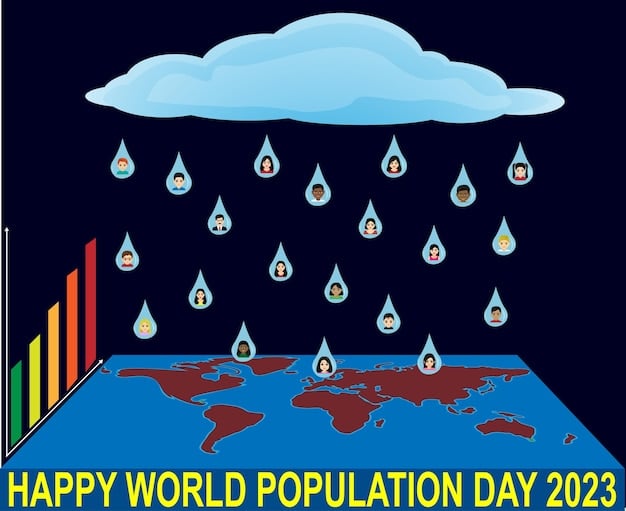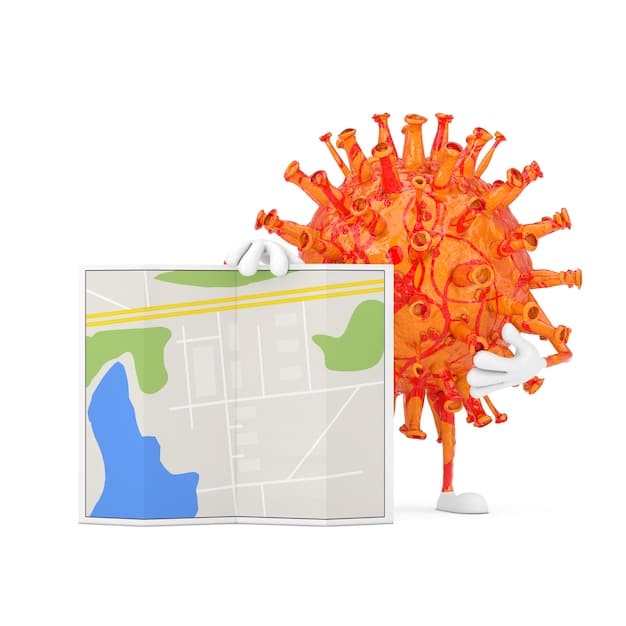Climate Change & Public Health: The Rising Threat of Infectious Diseases

Climate change significantly impacts public health by increasing the risk and spread of emerging infectious diseases, necessitating proactive preparation and mitigation strategies.
The intricate link between climate change and public wellbeing is becoming increasingly apparent, particularly concerning the emergence and spread of infectious diseases. Understanding the impact of climate change on public health: preparing for emerging infectious diseases is not just an academic exercise; it’s a crucial step toward safeguarding our future.
Climate Change: A Public Health Emergency
Climate change, driven by greenhouse gas emissions, is no longer a distant threat; it’s a present-day reality reshaping our planet. Its impact extends far beyond rising sea levels and extreme weather events, directly influencing the health of populations worldwide. The changing climate creates conditions ripe for the emergence and spread of infectious diseases, posing significant challenges to public health systems.
Understanding the multifaceted ways in which climate change exacerbates public health risks is paramount. From altered disease vectors to increased food and water contamination, the consequences are far-reaching and demand immediate attention.

Direct and Indirect Health Impacts
The health impacts of climate change are both direct and indirect. Direct impacts include heat-related illnesses, respiratory problems from air pollution, and injuries or deaths from extreme weather events. Indirect impacts, on the other hand, encompass changes in disease patterns, food security, and mental health.
- Extreme Heat: Rising temperatures contribute to heatstroke, dehydration, and cardiovascular stress, particularly affecting vulnerable populations like the elderly and those with chronic conditions.
- Air Pollution: Climate change intensifies air pollution, increasing respiratory illnesses such as asthma and bronchitis.
- Extreme Weather: Floods, droughts, and storms can cause injuries, displacement, and disrupt access to essential health services.
These impacts are not evenly distributed; marginalized communities and low-income countries often bear the brunt of the health consequences, exacerbating existing health inequities.
In conclusion, climate change presents a multifaceted threat to public health, ranging from direct physical impacts to subtle changes in infectious disease patterns. Addressing this emergency demands a comprehensive understanding of these impacts combined with proactive strategies to ensure a healthy future.
The Rise of Emerging Infectious Diseases
Emerging infectious diseases (EIDs) are diseases that are newly appeared in a population or have existed but are rapidly increasing in incidence or geographic range. Climate change plays a significant role in the emergence and re-emergence of these diseases, creating opportunities for pathogens to thrive and spread.
Understanding the complex interplay between climate change and EIDs is crucial for developing effective prevention and control strategies. This involves monitoring changes in disease vectors, understanding pathogen survival, and implementing robust surveillance systems.
Climate Change and Vector-Borne Diseases
Vector-borne diseases, transmitted by insects like mosquitoes and ticks, are particularly sensitive to climate change. Rising temperatures and altered rainfall patterns can expand the geographic range of vectors, increasing the risk of diseases like malaria, dengue fever, and Zika virus.
- Malaria: Warmer temperatures accelerate the mosquito life cycle and increase the parasite’s development rate, expanding malaria’s range into previously unaffected areas.
- Dengue Fever: Changes in rainfall patterns and increased temperatures create breeding grounds for Aedes mosquitoes, resulting in more frequent and severe dengue outbreaks.
- Zika Virus: Similar to dengue, the Zika virus benefits from warmer conditions that support mosquito populations and their ability to transmit the virus.
Controlling vector populations and implementing personal protective measures are essential for mitigating the risk of these diseases.

Climate shifts are altering the landscape of infectious diseases, turning previously stable regions into potential hotspots. Monitoring these shifts is the first line of defense in preventing widespread outbreaks.
Impact on Waterborne and Foodborne Diseases
Climate change also influences the incidence of waterborne and foodborne diseases. Extreme weather events, such as floods and droughts, can contaminate water supplies and compromise food safety, leading to outbreaks of diseases like cholera, salmonellosis, and E. coli infections.
Ensuring access to clean water and promoting safe food handling practices are critical for protecting public health in the face of climate change.
Contamination Pathways
Flooding can overwhelm sewage systems and contaminate water sources with pathogens. Droughts, on the other hand, can concentrate pollutants in water, increasing the risk of exposure.
- Cholera: Warming waters and increased runoff create favorable conditions for the spread of cholera bacteria.
- Salmonellosis: Warmer temperatures promote the growth of Salmonella in food, increasing the risk of food poisoning.
- E. coli Infections: Contaminated water and food can lead to outbreaks of E. coli infections, causing severe gastrointestinal illness.
Investing in water treatment infrastructure and promoting hygiene education are vital for preventing these diseases.
In summary, the intersection of climate change and infectious diseases poses a grave threat, warranting a proactive and multifaceted public health response. By understanding how climate change drives the emergence of diseases, adopting preventive measures to control vectors, and ensuring access to sanitation, communities can build resilience in the face of growing health risks.
Vulnerable Populations and Health Inequities
The impact of climate change on public health is not uniform; certain populations are disproportionately vulnerable due to factors such as socioeconomic status, geographic location, and pre-existing health conditions. Addressing health inequities is crucial for ensuring that all individuals have the opportunity to thrive in a changing climate.
Understanding which populations are most at risk and why is the critical first step. Effective public health interventions must address underlying social determinants of health and promote equitable access to resources.
Identifying High-Risk Groups
Several populations are particularly vulnerable to the health impacts of climate change:
- Low-Income Communities: Often lack access to adequate housing, healthcare, and clean water, making them more susceptible to climate-related health risks.
- Elderly Individuals: More prone to heat-related illnesses and may have chronic conditions that exacerbate the effects of climate change.
- Children: Their developing bodies are more vulnerable to environmental hazards, including air pollution and infectious diseases.
Protecting these populations requires targeted interventions and policies that address their specific needs and vulnerabilities.
In conclusion, climate change’s impact on health is uneven, magnifying existing inequalities. Prioritizing and directing resources to high-risk groups is essential for mitigating this threat and fostering resilient, healthy communities.
Building Resilient Health Systems
Strengthening health systems is essential for preparing for the health impacts of climate change. This includes improving surveillance, enhancing emergency response capacity, and integrating climate considerations into healthcare planning.
A resilient health system can effectively prevent, detect, and respond to climate-sensitive health threats, protecting populations from the worst effects of climate change.
Key Strategies for Health System Resilience
- Surveillance: Implementing robust surveillance systems to track the incidence and spread of infectious diseases, providing early warning of potential outbreaks.
- Emergency Response: Improving emergency response capacity to address climate-related health events, such as heat waves, floods, and disease outbreaks.
- Climate-Informed Healthcare: Integrating climate considerations into healthcare planning, ensuring that health professionals are prepared to address the health impacts of climate change.
Investing in health system resilience is a cost-effective way to protect public health in a changing climate.
In summary, a resilient healthcare system is proactive, prepared, and adaptable. By investing in surveillance, emergency response, and climate-informed healthcare, communities can build robust defenses against increasing health risks associated with climate change.
Policy and Mitigation Strategies
Addressing the health impacts of climate change requires a multifaceted approach that includes both mitigation and adaptation strategies. Mitigation focuses on reducing greenhouse gas emissions, while adaptation aims to reduce vulnerability to the impacts of climate change.
Effective policies and strategies must be evidence-based, equity-focused, and implemented in partnership with communities and stakeholders.
Examples of Effective Strategies
Examples of effective policies and strategies include:
- Renewable Energy: Investing in renewable energy sources, such as solar and wind power, to reduce greenhouse gas emissions and improve air quality.
- Sustainable Transportation: Promoting sustainable transportation options, such as public transit, cycling, and walking, to reduce air pollution and greenhouse gas emissions.
- Climate-Resilient Infrastructure: Building climate-resilient infrastructure, such as flood defenses and drought-resistant water systems, to protect communities from extreme weather events.
These strategies not only reduce greenhouse gas emissions but also provide co-benefits for public health, such as cleaner air and water, healthier diets, and more active lifestyles.
Ultimately, an integrated approach combining mitigation and adaptation is crucial for protecting public health in a changing climate. Prioritizing policies that improve environmental quality also protects public health, creating healthier communities and a more sustainable future.
| Key Point | Brief Description |
|---|---|
| 🌡️ Rising Temperatures | Increased heat-related illnesses and expanded vector-borne disease ranges. |
| 🌊 Extreme Weather | Contamination of water supplies leads to waterborne disease outbreaks. |
| 🦟 Vector-Borne Diseases | Changes in climate conditions cause spread of malaria, dengue, and Zika. |
| 🛡️ Protecting Health | Implementing mitigation and adaptation strategies protects most vulnerable populations. |
Frequently Asked Questions (FAQ)
▼
Climate change alters habitats, impacting vectors like mosquitoes that carry diseases. Warmer temperatures also help diseases spread more quickly and to broader areas. This increases the risk of exposure to various infections.
▼
Populations in low-income communities, the elderly, and children are particularly vulnerable. These groups often lack resources or have weakened immune systems, increasing their susceptibility to climate-related health problems.
▼
Key waterborne diseases affected by climate change include cholera, salmonellosis, and E. coli infections. Extreme weather contaminates water supplies.
▼
Yes, by improving disease surveillance, enhancing emergency response, and integrating climate considerations into healthcare planning.. Strengthened health systems help mitigate climate change health impacts.
▼
Individuals can adopt sustainable practices like using public transit, conserving energy, and supporting policies that promote renewable energy. Collective action helps reduce risks.
Conclusion
Addressing the impact of climate change on public health: preparing for emerging infectious diseases is a complex but vital undertaking. By understanding the many ways climate change elevates health risks, embracing proactive preventive strategies, and forging resilient healthcare systems, we can significantly diminish these threats and secure a healthier, more sustainable future for all.





